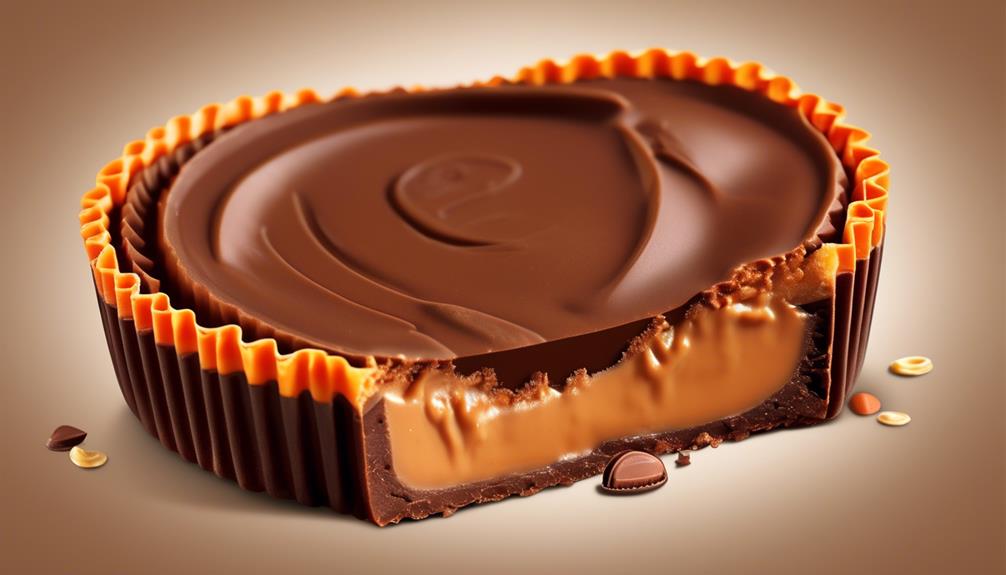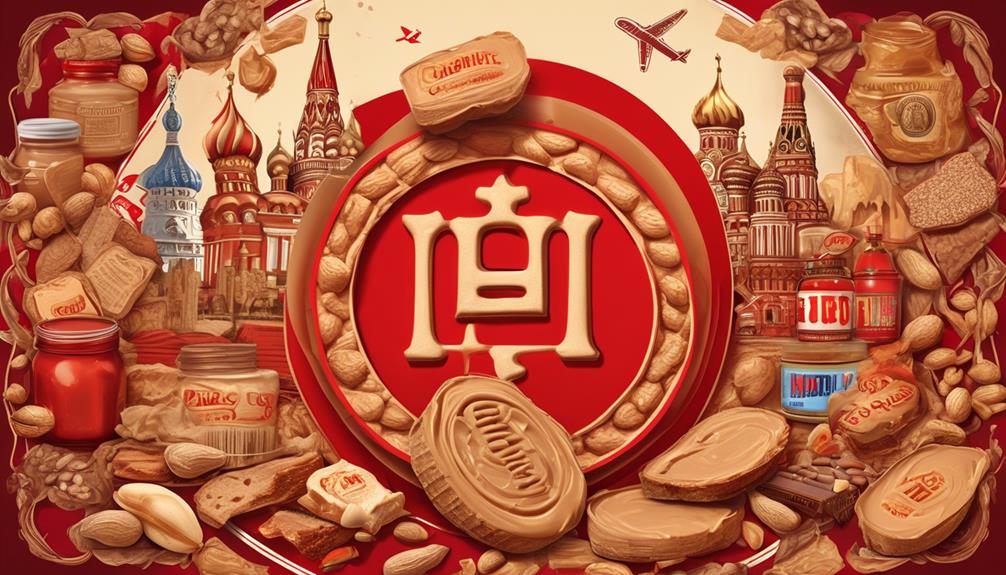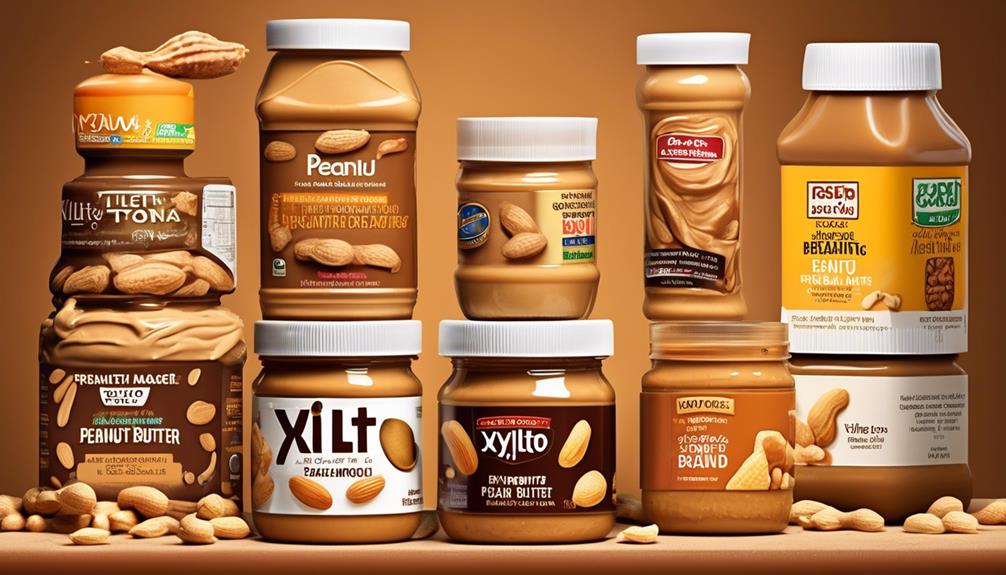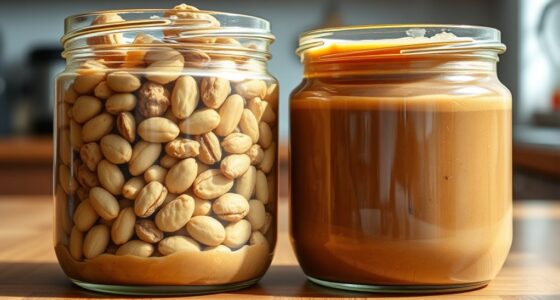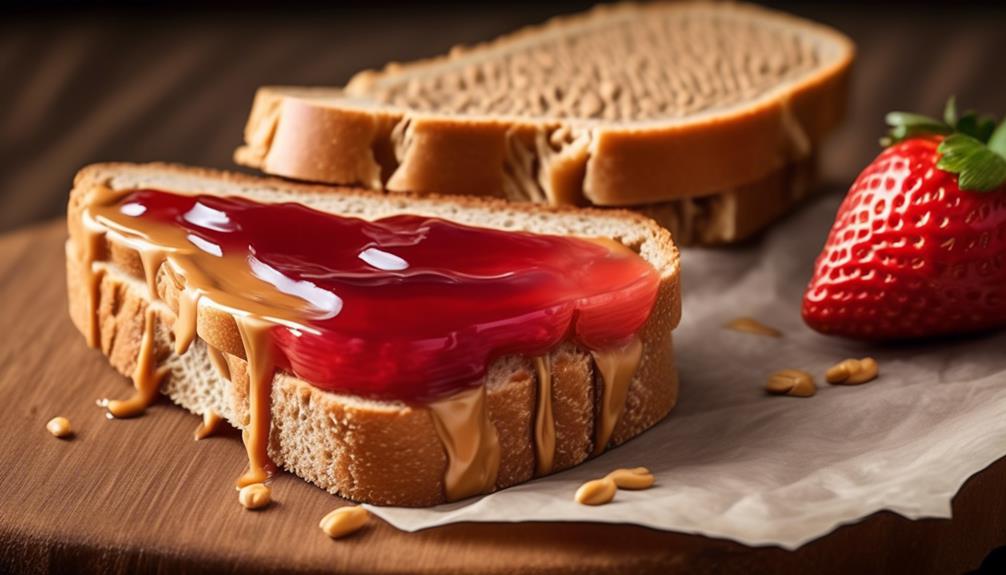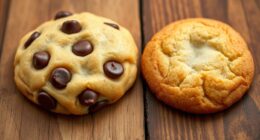We are all familiar with the irresistible pairing of chocolate and peanut butter in a Reese’s Peanut Butter Cup. But have you ever stopped to think about what ingredients are used in that smooth filling?
The ingredients may surprise you. As we explore the key components of this beloved treat, we'll uncover the secrets behind its delectable taste and texture.
But there's more to it than just the ingredients – the process of crafting this iconic filling is equally intriguing.
So, let's dig into the fascinating world of Reese's Peanut Butter Cup filling and uncover what makes it a timeless favorite.
Key Takeaways
- Reese's Peanut Butter Cups have a rich history and are one of the top-selling candy brands in the United States.
- The key ingredients in the filling include creamy peanut butter, powdered sugar, salt, and corn syrup, which provide the iconic taste and texture.
- The flavor profile of Reese's Peanut Butter Cups is a combination of sweet and slightly salty flavors, with a smooth and creamy texture.
- The manufacturing process involves melting chocolate, creating the peanut butter filling, layering it in cupcake pan wells, and refrigerating to set.
The Origin of Reese's Peanut Butter Cups
Established by H.B. Reese in 1923, in Hershey, Pennsylvania, Reese's Peanut Butter Cups were originally known as Penny Cups and were sold for one cent before evolving into the iconic confection they're today. The rich and creamy filling of Reese's Peanut Butter Cups is a blend of smooth peanut butter, powdered sugar, a hint of salt, and just the right amount of corn syrup. This delectable mixture is meticulously prepared and set aside before being carefully piped into the waiting chocolate cups, creating the perfect balance of sweet and salty flavors in every bite.
The journey of Reese's Peanut Butter Cups has been nothing short of extraordinary. From its humble beginnings as Penny Cups to becoming the most beloved and sought-after candy, this confection has left an indelible mark on the world of sweets. The merger with Hershey Chocolate Corporation in 1963 and the subsequent acquisition by The Hershey Company further solidified its place in the hearts of chocolate and peanut butter enthusiasts.
Over the years, Reese's Peanut Butter Cups has expanded its offerings to include various flavors, sizes, and seasonal editions, captivating the taste buds of countless individuals and securing its position as one of the top-selling candy brands in the United States.
The Key Ingredients in the Filling

We'll start by discussing the key ingredients that make up the filling of a Reese's Peanut Butter Cup.
The creamy peanut butter is the main component, providing the distinct flavor and texture of the filling.
Additionally, the powdered sugar, salt, and corn syrup are crucial in creating the smooth and sweet consistency of the peanut butter filling.
Filling Ingredients
The key ingredients in the filling of a Reese's Peanut Butter Cup consist of creamy peanut butter, powdered sugar, salt, and corn syrup, which are carefully combined to create the signature creamy and sweet filling.
The creamy peanut butter serves as the primary component, providing the distinct nutty flavor and smooth texture.
Powdered sugar is added to sweeten the filling, while salt enhances the overall flavor profile by balancing the sweetness.
Additionally, corn syrup acts as a binder, ensuring that the filling holds its shape and retains its creamy consistency.
The precise combination of these filling ingredients is crucial in achieving the iconic taste and texture that Reese's Peanut Butter Cups are known for.
This blend of peanut butter, powdered sugar, salt, and corn syrup results in the delectably indulgent filling that complements the rich chocolate shell.
Flavor and Texture
Combining the creamy peanut butter, powdered sugar, salt, and corn syrup results in a filling with a rich, smooth texture and a delightful balance of sweet and slightly salty flavors, complementing the iconic Reese's Peanut Butter Cup. The powdered sugar contributes to the smoothness and sweetness of the filling, while the salt enhances the peanut butter flavor. This creates a delectable, slightly grainy texture with a sweet, nutty flavor that perfectly complements the chocolate coating. The corn syrup binds the ingredients together, resulting in a firm yet smooth consistency that complements the chocolate. Below is a table summarizing the flavor and texture elements of the Reese's Peanut Butter Cup filling.
| Flavor | Texture |
|---|---|
| Sweet | Rich |
| Slightly Salty | Smooth |
| Nutty | Creamy |
| Balancing | Delectable |
The Texture and Consistency

With a velvety and pliable texture, the filling in a Reese's peanut butter cup provides a satisfying contrast to the chocolate coating, delivering a burst of sweet and nutty flavors when bitten into. The creamy peanut butter filling is smooth and dense, creating a delightful sensation on the palate. It melts in the mouth, leaving a rich and indulgent taste that lingers.
The combination of powdered sugar, creamy peanut butter, and corn syrup gives the filling its firm yet yielding texture, making it easy to handle and enjoy. The filling is pliable and holds its shape well, adding to the overall experience of biting into a Reese's peanut butter cup. Whether it's the creamy or crunchy version, the consistency of the peanut butter filling remains consistently satisfying, offering a delightful contrast to the chocolate exterior.
The Nutritional Composition

We need to consider the nutritional composition of Reese's Peanut Butter Cup filling to understand its impact on our diet.
The calorie count of 312 per serving and the total fat content of 18.8g are significant factors to analyze.
Additionally, we should pay attention to the levels of saturated fat, trans fat, and cholesterol to make informed dietary decisions.
Ingredients and Calories
The nutritional composition of the Reese's Peanut Butter Cup filling reveals that it contains approximately 276 calories per serving, with 18g of fat, 8g of saturated fat, and 20mg of cholesterol.
The filling also consists of about 25g of carbohydrates and 5g of protein, with 21g of sugar and 1g of fiber.
The creamy peanut butter, powdered sugar, salt, and corn syrup come together to create this delectable filling.
Despite its delicious taste, it's essential to consume it in moderation due to its relatively high fat and calorie content.
The combination of creamy peanut butter and sweet powdered sugar gives the filling its rich, indulgent flavor, while the salt and corn syrup balance the sweetness and enhance the overall taste of the Reese's Peanut Butter Cup.
Sugar and Protein
Pivoting from our discussion of the nutritional composition in terms of fat and carbohydrates, we now turn our focus to the pivotal components of sugar and protein present in the Reese's peanut butter cup filling.
The filling contains a significant amount of powdered sugar, which sweetens the peanut butter and provides structure. This addition of powdered sugar contributes to the overall sugar content of the filling.
Furthermore, the peanut butter itself adds a notable amount of protein to the filling, enhancing its nutritional composition. The combination of sugar and protein in the filling provides energy and can contribute to satiety.
When considering the nutritional aspects of the Reese's peanut butter cup filling, it's important to acknowledge the balance of sugar and protein, especially if incorporating it into a balanced diet.
The Manufacturing Process

Melting the chocolate wafers is the initial step in the manufacturing process of Reese's Peanut Butter Cup filling. The process involves carefully spreading a ¼-inch thick layer of melted chocolate into cupcake pan wells, creating the base of the peanut butter cups.
The peanut butter filling is then meticulously prepared by microwaving the peanut butter and blending it with powdered sugar, salt, and corn syrup until the mixture is smooth and clump-free.
Once the chocolate layer is set, the peanut butter filling is added as a disk into each well, and then topped with another layer of melted chocolate to encase the filling.
The filled cupcake pan is then refrigerated for at least 30 minutes to allow the peanut butter cups to set.
This meticulous manufacturing process ensures that each Reese's Peanut Butter Cup has a perfect balance of chocolate and peanut butter, resulting in the irresistible taste that has made them a beloved treat for generations.
The Taste and Flavor Profile

When we explore the taste and flavor profile of the Reese's Peanut Butter Cup filling, we can break it down into three key points:
- The flavor components
- The balance of sweetness and saltiness
- The texture and consistency
These aspects play a crucial role in defining the overall sensory experience of this iconic treat. By examining each point in detail, we can gain a deeper understanding of what makes the filling so beloved and distinctive.
Flavor Components
The taste and flavor profile of a food product are shaped by a complex interplay of flavor components, including sweetness, saltiness, bitterness, and other key elements, which collectively contribute to the overall sensory experience. When it comes to Reese's Peanut Butter Cups, the flavor components play a crucial role in defining their delectable taste.
- Sweetness: The sweetness in Reese's Peanut Butter Cups comes from the chocolate and the sugar content in the peanut butter filling, creating a delightful and indulgent flavor.
- Saltiness: The saltiness in the peanut butter filling provides a savory contrast to the sweetness of the chocolate, enhancing the overall flavor profile with a hint of salt.
- Peanut Butter Flavor: The rich, nutty flavor of the peanut butter is a dominant flavor component, adding depth and a distinctive taste to the filling of Reese's Peanut Butter Cups.
Sweetness and Saltiness
The flavor components of Reese's Peanut Butter Cups, particularly the interplay between sweetness and saltiness, contribute significantly to their delectable taste and complex flavor profile.
The creamy peanut butter filling provides a rich, nutty sweetness that's complemented by the savory saltiness. This balance between sweet and salty creates a harmonious flavor experience that tantalizes the taste buds.
Additionally, the chocolate shell adds a layer of sweetness, while also offering a hint of bitterness that further enhances the overall flavor profile.
The combination of these elements results in a well-balanced and indulgent taste that has made Reese's Peanut Butter Cups a beloved treat for generations.
Understanding the intricate relationship between sweetness and saltiness is key to appreciating the delightful complexity of this iconic candy.
Texture and Consistency
To comprehend the texture and consistency of Reese's Peanut Butter Cup filling, it's imperative to analyze its composition and structural attributes.
- The filling combines creamy peanut butter, powdered sugar, salt, and corn syrup, resulting in a smooth and creamy texture with a slightly firm consistency.
- The creamy peanut butter provides a velvety richness, while the addition of powdered sugar and corn syrup contributes to the firmness, creating a perfect blend of smoothness and stability.
- When savored, the filling offers a delightful contrast to the chocolate coating, enhancing the overall experience with its creamy yet slightly firm texture.
This amalgamation of creamy peanut butter, powdered sugar, and corn syrup ensures a gratifying textural experience, adding depth to the overall indulgence of a Reese's Peanut Butter Cup.
The Popularity and Demand

With its irresistible combination of chocolate and peanut butter, Reese's Peanut Butter Cups have become a globally sought-after and highly coveted candy treat. The unique filling, consisting of creamy peanut butter, powdered sugar, salt, and corn syrup, contributes to the distinct flavor profile that has captured the hearts of consumers worldwide. The popularity of Reese's Peanut Butter Cups can be attributed to the universal appeal of the peanut butter and chocolate pairing. This classic flavor combination transcends cultural and geographical boundaries, making it a beloved choice for consumers of all ages.
The demand for Reese's Peanut Butter Cups remains consistently high, with the brand offering a wide range of options, including seasonal and specialty flavors, as well as various sizes and shapes. This versatility caters to diverse consumer preferences, ensuring that the product maintains its popularity throughout the year.
The widespread integration of Reese's Peanut Butter Cups into recipes and desserts further demonstrates its enduring allure, cementing its status as a cultural icon in the confectionery world. The brand's successful advertising campaigns and continued innovation have solidified the enduring demand for Reese's peanut butter products, making them a staple in the global candy market.
The Unique Selling Points

Boasting a quick and easy preparation process with only five essential ingredients, the Reese's Peanut Butter Cup filling offers a classic and indulgent flavor combination of creamy peanut butter and rich chocolate.
The simplicity of creating these peanut butter cups makes them an ideal choice for a quick and satisfying treat.
The timeless pairing of peanut butter and chocolate has solidified its place as a beloved flavor combination for consumers of all ages.
The ability to customize the filling with mix-ins and toppings allows for a personalized touch, appealing to those with specific flavor preferences.
The allure of Reese's peanut butter cups lies in their effortless assembly, nostalgic taste, and adaptable nature.
These unique selling points position the product as a versatile and convenient indulgence.
When consumers seek a familiar yet customizable treat, the Reese's peanut butter cup filling stands out as a top contender.
The Historical Evolution

The historical evolution of Reese's Peanut Butter Cups reflects the brand's enduring popularity and innovation in the confectionery industry. Established in 1923 by H.B. Reese in Hershey, Pennsylvania, Reese's Peanut Butter Cups were originally named Penny Cups and sold for one cent. The popularity of Reese's Peanut Butter Cups led to a merger with Hershey Chocolate Corporation in 1963 and subsequent acquisition by The Hershey Company, paving the way for its widespread availability and continued success.
The product has evolved to include a diverse array of varieties and flavors. This includes dark chocolate, white chocolate, limited edition seasonal flavors, specialty flavors, and various size and filling variations, providing consumers with a wide range of options to suit their preferences.
In addition to the classic peanut butter cups, Reese's also offers other products such as the Crispy Crunchy candy bar, Fast Break candy bar, Plant-Based Peanut Butter Cups, Snack Bar, and Sticks, showcasing the brand's adaptability and commitment to innovation.
Over the years, Reese's has maintained its position as one of the top-selling candy brands in the United States through strategic marketing, memorable advertising campaigns, and collaboration with other brands. This has solidified its status as a beloved and iconic confectionery brand.
The Cult Following

Reese's Peanut Butter Cups have cultivated a devoted and passionate following, characterized by a fervent loyalty and shared enthusiasm for the brand's unique and unconventional appeal. This cult following has arisen due to several key factors:
- Peanut Butter Adoration: The cult following has been driven by the deep-seated adoration for peanut butter. Reese's peanut butter cups are celebrated for their creamy and rich peanut butter filling, which has become a cornerstone of the brand's identity. This has resonated with individuals who have an unwavering fondness for the distinct flavor and texture of peanut butter.
- Shared Experiences: The cult following of Reese's peanut butter cups extends beyond mere enjoyment of the product. It has fostered a shared experience amongst its followers, who often engage in communal activities, discussions, and events centered around their love for the peanut butter cups. This sense of belonging and camaraderie has further solidified the cult following.
- Brand Loyalty: The brand's ability to maintain a consistent and high-quality product over the years has garnered unwavering loyalty from its followers. The unchanging, yet beloved, recipe for the peanut butter filling has played a pivotal role in sustaining this cult following.
The Secret Recipe Speculations

We've been pondering the secret behind Reese's Peanut Butter Cup filling, and it's time to explore the points that have been circulating in discussions.
The ingredients and flavors, the texture and consistency, and the manufacturing process are all critical aspects to consider when speculating about the secret recipe.
Ingredients and Flavors
Speculating about the secret recipe for Reese's Peanut Butter Cup filling leads to intriguing discussions about its distinctive flavors and ingredients. As we delve into the realm of the unknown, we can't help but ponder the exact blend of elements that create the iconic taste of this delectable treat. Our curiosity centers around the precise combination of:
- Peanut Butter: The primary ingredient, which brings a rich, nutty flavor and a creamy texture to the filling.
- Chocolate: The luscious, melted chocolate that enrobes the peanut butter filling, adding a layer of sweetness and depth to the overall taste.
- Powdered Sugar, Salt, and Corn Syrup: These elements come together to enhance the sweetness, balance the flavors, and provide the desired consistency to the filling.
The complex interplay of these ingredients results in the unmistakable and irresistible flavor profile of the Reese's Peanut Butter Cup.
Texture and Consistency
To achieve the desired texture and consistency for the peanut butter filling in a Reese's Peanut Butter Cup, the ingredients must be precisely combined and carefully shaped before being enrobed in melted chocolate. The mixture of creamy peanut butter, powdered sugar, salt, and corn syrup should be thoroughly stirred until achieving a clump-free consistency. The peanut butter filling is then shaped into disks and placed into the chocolate-filled cupcake pan wells. A spoonful of melted chocolate is then used to fully cover the peanut butter filling in each well before refrigerating. This meticulous process ensures that the peanut butter filling maintains its creamy texture and pairs perfectly with the chocolate layer.
| Ingredients | Texture and Consistency |
|---|---|
| Creamy peanut butter | Smooth and consistent |
| Powdered sugar | Clump-free and uniform |
| Salt | Balanced and well-distributed |
| Corn syrup | Even and cohesive |
Manufacturing Process
The meticulous process used to achieve the desired texture and consistency of the peanut butter filling in a Reese's Peanut Butter Cup is an essential aspect that leads to the secret recipe speculations surrounding its manufacturing process.
- Melting: The process begins with microwaving the peanut butter to achieve a smooth and creamy texture, ensuring it blends seamlessly with the other ingredients.
- Mixing: The addition of powdered sugar, salt, and corn syrup is carefully measured and stirred into the peanut butter to create a cohesive filling that holds its shape inside the chocolate coating.
- Layering: After the filling is added to the chocolate-filled cupcake pan wells, another layer of melted chocolate is poured over the top before the cups are refrigerated, allowing the layers to set into the iconic Reese's Peanut Butter Cup.
The manufacturing process involves precision and attention to detail to deliver the perfect combination of peanut butter and chocolate in every bite.
The Filling's Role in Recipes

In recipe formulations, the filling of a Reese's peanut butter cup serves a pivotal role in achieving the desired flavor, texture, and consistency of the end product.
The creamy peanut butter, combined with powdered sugar, salt, and corn syrup, creates a sweet and savory flavor profile essential to the iconic taste of a Reese's peanut butter cup.
This unique filling also contributes significantly to the overall texture, providing a creamy and smooth consistency that complements the chocolate exterior.
The powdered sugar not only adds sweetness but also plays a crucial role in binding the ingredients together, ensuring a cohesive filling.
Additionally, the corn syrup is instrumental in establishing the desired texture and consistency, effectively contributing to the smooth and slightly firm nature of the peanut butter filling.
Understanding the interplay of these ingredients is essential for incorporating the filling into various recipes, as it not only provides flavor but also influences the texture and consistency of the final product.
This makes it a versatile and indispensable component in creating delectable treats with a distinct peanut butter and chocolate flavor.
The Filling's Global Appeal

As we consider the global appeal of the Reese's peanut butter cup filling, it becomes evident that its iconic flavor combination and adaptable nature have contributed to its widespread recognition and popularity across diverse consumer markets.
- Classic Flavor Combination: The timeless pairing of peanut butter and chocolate in the filling appeals to a wide range of palates, transcending cultural and regional differences. This classic combination provides a familiar and comforting taste that resonates with consumers worldwide.
- Quick and Easy Preparation: The no-bake nature of the filling makes it a convenient choice for consumers seeking a delicious treat without the need for complex cooking techniques. This ease of preparation has contributed to its global appeal, allowing individuals from various backgrounds to indulge in its flavor without extensive culinary skills.
- Customizable with Mix-Ins and Toppings: The adaptability of the filling to incorporate mix-ins such as chocolate chips and various toppings allows for personalization, catering to diverse preferences and culinary traditions. This flexibility has played a significant role in its widespread acceptance and integration into international cuisines and confectionery offerings.
The Reese's peanut butter cup filling's global popularity is a testament to its ability to transcend borders and resonate with a wide spectrum of consumers, making it a beloved treat across the world.
The Future Innovations

Evolving at an exponential pace, future innovations are poised to reshape industries across the globe, incorporating cutting-edge technology and advancements to drive progress and efficiency.
In the realm of confectionery, the future of peanut butter cups holds exciting potential. With the advancement of 3D printing technology, confectionery manufacturers may soon be able to create custom peanut butter cup designs, allowing consumers to personalize their treats.
Additionally, the use of innovative ingredients and flavor combinations could pave the way for a new generation of copycat Reese's peanut butter cups, offering diverse options to cater to evolving consumer preferences.
Furthermore, advancements in sustainable packaging materials and production processes may lead to environmentally friendly packaging for peanut butter cups, aligning with the growing demand for eco-conscious practices. The integration of blockchain technology could also offer consumers unprecedented transparency into the sourcing of ingredients, ensuring quality and ethical standards are met.
As the confectionery industry embraces automation and smart manufacturing, the future holds the promise of enhanced efficiency and consistency in producing peanut butter cups, while also driving down costs and reducing waste.
These innovations are set to elevate the peanut butter cup experience, offering consumers a blend of tradition and cutting-edge technology.
Frequently Asked Questions
What Is the Main Filling in Reese's?
We're here to discuss the main filling in Reese's. It's a luscious blend of creamy peanut butter, powdered sugar, salt, and corn syrup.
We microwave the peanut butter, then mix in the powdered sugar, salt, and corn syrup until it's smooth. This heavenly mixture is combined with melted chocolate in a cupcake pan to create the classic Reese's Peanut Butter Cup.
After chilling, the filling sets, giving us that irresistible treat.
What Is a Reese's Peanut Butter Cup Made Of?
We love Reese's Peanut Butter Cups! They're made of creamy peanut butter, powdered sugar, salt, and corn syrup for the filling.
The peanut butter filling is created by microwaving the peanut butter, then mixing it with powdered sugar, salt, and corn syrup until smooth and clump-free.
The chocolate layers are made by melting milk chocolate wafers and creating a ¼-inch thick layer in each cupcake pan well.
Is It Real Peanut Butter in Reese's?
Yes, it's real peanut butter in Reese's. The creamy filling is made of peanut butter, powdered sugar, salt, and corn syrup. We mix these until fully combined and clump-free.
After pouring a layer of melted chocolate in each cupcake well, we shape the peanut butter filling into disks and place them on top before covering with more chocolate.
What Are Reeses Pieces Filled With?
Reese's Pieces are filled with a combination of peanut butter and a candy shell.
The peanut butter filling is made of creamy peanut butter, powdered sugar, salt, and corn syrup, giving it a smooth and sweet taste.
The candy shell provides a crunchy texture and adds a pop of color to the treat.
The combination of these elements creates the iconic flavor and texture of Reese's Pieces that we all love.
Conclusion
In conclusion, the creamy and sweet filling of a Reese's Peanut Butter Cup is a harmonious blend of peanut butter, powdered sugar, salt, and corn syrup, encased in a layer of milk chocolate.
This delectable combination creates a symphony of flavors and textures that has captured the hearts of chocolate and peanut butter lovers worldwide. Just like a well-composed piece of music, the filling in a Reese's Peanut Butter Cup is a delightful masterpiece that continues to captivate and satisfy its audience.
